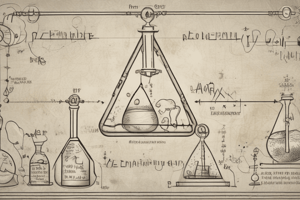Podcast
Questions and Answers
Explain the difference between qualitative and quantitative reasoning in the context of chemistry.
Explain the difference between qualitative and quantitative reasoning in the context of chemistry.
Qualitative reasoning in chemistry involves describing the properties or characteristics of substances or reactions, while quantitative reasoning involves using numerical data and measurements to analyze and solve chemical problems.
Why is it important to balance chemical equations to satisfy the law of conservation of matter? Provide a detailed explanation.
Why is it important to balance chemical equations to satisfy the law of conservation of matter? Provide a detailed explanation.
Balancing chemical equations is important to satisfy the law of conservation of matter, which states that matter cannot be created or destroyed in a chemical reaction. Balancing ensures that the same number of each type of atom is present on both sides of the equation, maintaining the overall mass and quantity of matter before and after the reaction.
Provide an example of a chemical equation and demonstrate how it can be balanced using qualitative and quantitative reasoning.
Provide an example of a chemical equation and demonstrate how it can be balanced using qualitative and quantitative reasoning.
An example chemical equation is the combustion of methane: CH4 + O2 -> CO2 + H2O. Qualitatively, we can observe that there is one carbon atom on each side and four hydrogen atoms on each side. Quantitatively, we can use coefficients to balance the equation, resulting in CH4 + 2O2 -> CO2 + 2H2O.
Abstraction
Abstraction
Accelerating change
Accelerating change
Action language
Action language
Action model learning
Action model learning
Flashcards are hidden until you start studying



